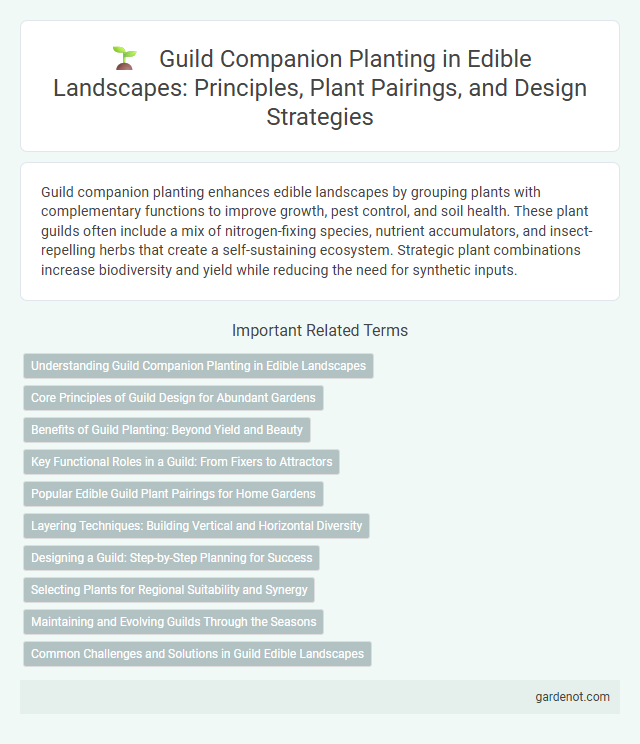Guild companion planting enhances edible landscapes by grouping plants with complementary functions to improve growth, pest control, and soil health. These plant guilds often include a mix of nitrogen-fixing species, nutrient accumulators, and insect-repelling herbs that create a self-sustaining ecosystem. Strategic plant combinations increase biodiversity and yield while reducing the need for synthetic inputs.
Understanding Guild Companion Planting in Edible Landscapes
Guild companion planting in edible landscapes involves strategically grouping plants that support each other's growth, pest control, and nutrient cycling. Typical guilds include a central fruit tree surrounded by nitrogen-fixing plants, dynamic accumulators, and insect-repelling herbs, creating a self-sustaining ecosystem. This method enhances biodiversity, improves soil health, and increases overall productivity in permaculture garden designs.
Core Principles of Guild Design for Abundant Gardens
Guild companion planting relies on planting diverse species that support each other through nutrient cycling, pest control, and soil improvement. Core principles of guild design include selecting plants with complementary functions such as nitrogen-fixing legumes, deep-rooted dynamic accumulators, and ground covers that suppress weeds and retain moisture. This strategic layering enhances biodiversity and creates resilient, self-sustaining edible landscapes with higher yields and improved ecosystem health.
Benefits of Guild Planting: Beyond Yield and Beauty
Guild companion planting enhances edible landscapes by promoting biodiversity, improving soil health, and naturally managing pests, leading to resilient garden ecosystems. Combining nitrogen-fixing plants, dynamic accumulators, and insectary species supports nutrient cycling and attracts beneficial insects, which reduces the need for chemical inputs. This integrated approach increases overall productivity while fostering sustainable, low-maintenance gardens rich in ecological interactions.
Key Functional Roles in a Guild: From Fixers to Attractors
Guild companion planting in edible landscapes integrates key functional roles such as nitrogen fixers, nutrient accumulators, and pest repellents to optimize plant health and productivity. Nitrogen fixers like clover enrich the soil by converting atmospheric nitrogen into usable forms, while nutrient accumulators such as comfrey draw minerals from deep within the soil to surface layers. Attractors including flowering herbs and beneficial insect habitats improve pollination and natural pest control, creating a balanced, self-sustaining ecosystem.
Popular Edible Guild Plant Pairings for Home Gardens
Popular edible guild plant pairings for home gardens include the classic "Three Sisters" combination of corn, beans, and squash, which naturally support each other's growth by providing structural support, nitrogen fixation, and ground cover. Herb companions like basil, chives, and marigolds enhance pest resistance and improve pollination when planted alongside tomatoes, peppers, and cucumbers. Fruit trees paired with dynamic accumulators such as comfrey and nitrogen-fixing plants like clover create a sustainable ecosystem that maximizes soil health and crop yields.
Layering Techniques: Building Vertical and Horizontal Diversity
Guild companion planting in edible landscapes enhances productivity by using layering techniques that build both vertical and horizontal diversity. Vertical layers include canopy trees, understory shrubs, herbaceous plants, ground covers, and root crops, which maximize space utilization and create beneficial microclimates. Horizontal diversity integrates multiple species side by side, promoting pest control, nutrient cycling, and improved soil health through synergistic plant interactions.
Designing a Guild: Step-by-Step Planning for Success
Designing a guild for edible landscapes involves selecting complementary plants that support each other's growth and soil health, such as nitrogen-fixing legumes, deep-rooted nutrient accumulators, and insect-attracting flowers. Begin by analyzing site conditions and choosing a central "hub" plant like a fruit tree or shrub, then layer companion species that provide pest control, ground cover, and mulch. Detailed planning ensures sustainable yields, improves biodiversity, and maximizes space efficiency within the guild ecosystem.
Selecting Plants for Regional Suitability and Synergy
Selecting plants for guild companion planting requires careful consideration of regional climate, soil types, and native species to enhance growth and resilience. Combining nitrogen-fixing plants like clover with deep-rooted species such as comfrey promotes nutrient cycling and soil structure improvement. Integrating pest-repellent herbs like marigolds within fruit tree guilds supports natural pest control while boosting overall ecosystem health.
Maintaining and Evolving Guilds Through the Seasons
Maintaining and evolving guild companion planting through the seasons involves careful observation of plant interactions and timely adjustments to ensure biodiversity and soil health. Seasonal pruning, mulching, and interplanting with dynamic accumulators or nitrogen-fixers help sustain nutrient cycling and pest control within the guild. Monitoring plant health and replacing or rotating species adapts the edible landscape to changing environmental conditions, promoting resilience and continuous yield.
Common Challenges and Solutions in Guild Edible Landscapes
Guild companion planting in edible landscapes often faces challenges such as nutrient competition, pest attraction, and plant compatibility issues. Solutions include strategic species selection to balance nutrient uptake, incorporation of pest-repellent plants like marigolds to minimize infestations, and maintaining biodiversity to enhance soil health and plant resilience. Proper spacing and ongoing monitoring further optimize plant interactions and overall guild productivity.
Guild companion planting Infographic

 gardenot.com
gardenot.com